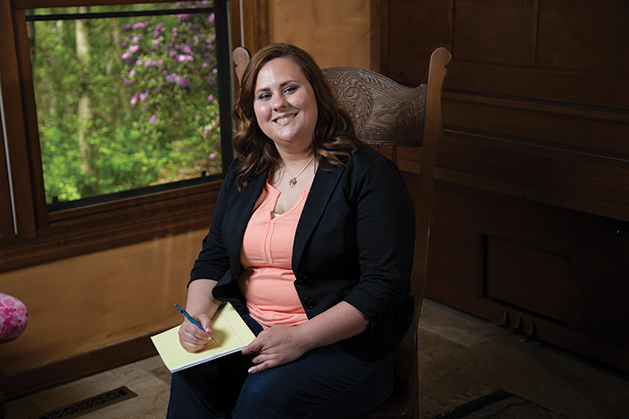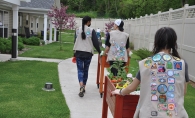
Amanda Lathrop sits in her family's heirloom rocking chair at her parents' Woodbury home. Lathrop now helps other families tell their stories, too.
“People just tell me things,” says Amanda Lathrop. The St. Paul resident and Woodbury native once had a complete stranger plop down next to her in an airport and tell her all about her divorce.
You can chalk it up to Lathrop’s bubbly, magnetic personality; her curiosity; or perhaps the attention to detail and conversation skills she developed while majoring in psychology at UW-River Falls. But it’s a skill set that served her well as she built a successful video career that took her to Prince’s Paisley Park and to the sets of TV shows likes Diners, Drive-ins and Dives, Bizarre Foods and MonsterQuest. She coordinated crews and props and did big-picture production, making sure creative elements came together to tell a compelling and cohesive story. It was a fun life, but a stressful one, with 3 a.m. calls from crews overseas and endless deadlines. But when she put together an interview-focused video for her grandparents’ 60th anniversary, her people-centered instincts took over, the project went well, and she fell in love anew with the raw storytelling power of video.
At the urging of her friends and family—and a rock band name generator app that suggested a name that instantly conjured up happy memories of a trip to Ireland with her grandma—she quit her job cold turkey and Lead Sheep Productions was born. She creates storytelling video packages that become gifts, creative elements at parties or funerals, or promotions for family-owned businesses. Though subjects change, Lathrop always does interviews in people’s own spaces, because personality comes through in what they own and how they interact with their things.
“It’s easier to tell things to a non-family member sometimes,” she says, noting how many times people have stopped to say they’d never told anyone a particular story before—or hadn’t thought of it in years. “People think of history as names and dates, but if you let people tell their slice of history, if you put life to it, then it really means something.”
Client Angela Olson, an upper-octogenarian, decided to document her story as a gift to her children. “At times I had been asked to write down some of my history, but did not take time, nor did I know how to start,” Olson says. After articulating her goals, she dug through hundreds of photos and newspaper articles to prepare for an on-camera interview.
It’s one of the projects Lathrop uses to illustrate the power of capturing stories in a visual way. A camera captures mannerisms, accents and facial expressions in ways writing can’t. You get a feel for someone’s emotions and not just life details, but how they choose to talk about them. Olson, for instance, throws German terms into her sentences without realizing it. At one point in her interview, Olson explained what it was like hiding in Germany during World War II. Lathrop stopped her to ask what, exactly, she had been hiding from. As Lathrop tells it, Olson looked up, puzzled, and without skipping a beat said, “The bombs.”
Lathrop says Olson’s expression was matter-of-fact, like this was simply a part of her life then, a reality she’d carried for years. While her kids had heard bits and pieces of her life story, two two-hour interviews captured it cohesively, in Olson’s words and voice. It was a gift to her kids, but in a way also served as a cathartic gift to herself.
“This was a wonderful experience. I enjoyed every minute Amanda was here,” says Olson of the experience. “She asked good questions and gave me time to think. I really wanted something my children would treasure after I am gone, and she did a wonderful job.”









